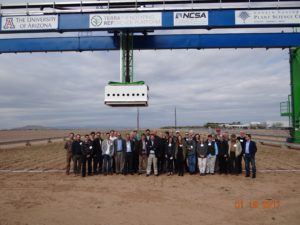26th January 2017 Science Innovation USA
The Future of Farming: How to Feed the Planet
The global population is expected to increase by 38% in 2050 from 6.9 billion in 2010 to 9.6 billion in 2050. With our increasing detriment to the environment and a changing climate, this alarming statistic begs the question: how will we feed everyone?
Plant phenomics, an emerging science that studies how a crop’s traits change under environmental influences, is trying to find the answer. For example, phenomics can help determine the best time to harvest potatoes or ensure a crop of asparagus can survive a drought. Through phenomics, scientists can discover which genetic traits of a given crop lead to greater yields.
Last week, the UK Science & Innovation Network sponsored experts from the UK to meet with their American counterparts at the University of Arizona’s Maricopa Agricultural Center and share their expertise in the field as well as discuss challenges that they are facing.

Specifically, the researchers discussed how to deliver genetic gains to farmers, how to best use sensor data, and how to use data to predict what happens in the field.
In addition to UK and US researchers, individuals from the US Department of Energy, the US National Science Foundation, the US Department of Agriculture and International Maize and Wheat Improvement Center (CIMMYT) (Mexico) attended. A smattering of US and international companies working on field phenotyping also attended to discuss their products and services.
Agriculture and food security is a priority for the UK government. The UK Science & Innovation Network recognized the need to pair best with best to further progress scientific developments in phenomics. As phenomics determines the crops that will deliver the largest yields, we will be able to feed our rapidly growing (and hungry) population.
